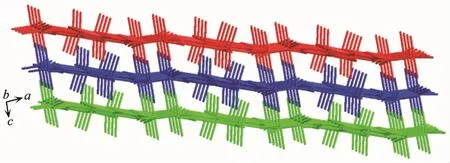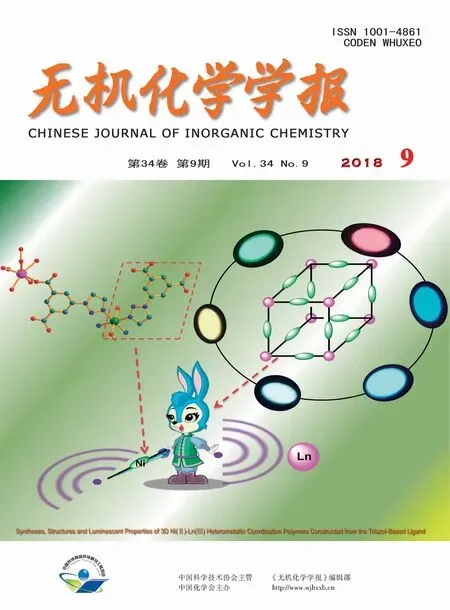由三羧基配体桥联的含有线性四核钴簇单元的二维层状配位聚合物的组装和性质
2018-09-03汪鹏飞
汪鹏飞
(1池州学院化学与材料工程学院,池州 247000)
(2南京大学配位化学国家重点实验室,南京 210023)
0 Introduction
Coordination polymers (CPs)are an established class of crystalline solids materials that formed by the assemblymetalionsormetalclusterunitsand functional organic ligands,and have attracted significant attention owing to their intriguing architectures and potential applications in many fields,such as gas storage,separation,catalysis,chemical sensors,luminescence[1-6].Another field where the CPs have attracted great interest is in the area of molecular magnetic materials[7-11].The magnetic properties containing the paramagnetic metal ions or metal cluster units of CPs can be well-tuned by suitable modification of the functional organic ligands,which affect the magnetic exchange pathways of the metal centers[12-14].As a class ofimportantfunctionalorganic ligands,aromatic multicarboxylate ligands are extensively employed in the synthesis of many CPs for their abundant coordinating modes to metal ions[15-18].However,the reported metal carboxylates CPs of a rigid aromatic multicarboxylate combination hydroxyl group are still rare[19].On the other hand,in order to construct interesting magnetic materials,it is seen as a general strategy to use paramagnetic transition metal ions with a large spin state,strongly anisotropic spin and suitable bridging ligands through the self-assembly way[20].The nature of the paramagnetic metal ions plays an important role in regulating the magnetic properties of CPs.In this work,we report a new Coギ-based CP that has been synthesized using 2-hydroxyl-1,3,5-benzenetricarboxylicacid (HO-H3BTC).TheHOH3BTC ligand with three carboxylic groups and one hydroxyl group,which possess seven coordinated sites and prefertofavorthegeneration ofthehigh dimensional structure with high rigidity for encapsulating many metal ions,has been used earlier as a useful building unit to obtain a three-dimensional framework[21].The CP reported in this paper is formulated as[Co2(O-BTC)(H2O)5]n(1),and it displays twodimensional(2D)layered structure,which is packed and stabilized by extensive hydrogen bonds among the carboxylate oxygen atomsand coordinated water molecules to form a three-dimensional supramolecular structure.In addition,the thermalstability and magnetic properties of 1 also were studied.
1 Experimental
1.1 Materials and methods
The ligand HO-H3BTC was prepared according to the literature procedure[22].The other reagents and solvents were commercially available and used without any purification.The infrared spectra(IR)were recorded with a Nicolet iS10 spectrometer by KBr pellets in the range of 4 000~500 cm-1.Elemental analyses(C and H)were performed on a Perkin-Elmer 240C elemental analyzer.Thermogravimetric analysis(TGA)was performed on a Netzsch STA 449C instrument under flowing N2atmosphere with a heating rate of 10℃·min-1from 30 to 800℃.Powder X-ray diffraction (PXRD)sample was carried out on a Rigaku UltimaⅣX-ray diffractometer using Cu Kα (λ=0.154 056 nm)radiation.The measurement was performed over the 2θ range of 5°~50°at room temperature.The operating power was set at 30 mA,40 kV.The dc magnetic susceptibility data were obtained on polycrystalline samples using a Quantum Design MPMS-XL7 SQUID magnetometer.
1.2 Synthesis of[Co2(O-BTC)(H2O)5]n(1)
A mixture of Co(NO3)2·6H2O(58.2 mg,0.2 mmol),HO-H3BTC(22.6 mg,0.1 mmol),and NaOH(8.0 mg,0.2 mmol)in H2O(10 mL)was stirred under ambient condition for 30 min.The mixture was then placed into a Teflon-lined stainless steel container (30 mL)and heated at 160℃for 72 h.After the mixture was slowly cooled to room temperature,red block-like crystals of 1 were obtained by filtering,washed with distilled water and ethanol,and dried in air.Yield:8.6 mg(20%based on Co).Elemental analysis Calcd.for C9H12Co2O12(%):C 25.12,H 2.79.Found(%):C 25.01,H 2.83.IR(KBr,cm-1):3 496(br),1 612(s),1 525(m),1 422(s),1 383(s),1 274(m),1 122(m),947(w),826(m),782(m),738(m),696(m),573(w).
1.3 X-ray crystallography
The single-crystal diffraction data of 1 were collected on a Bruker SMART APEXⅡCCD diffractometer equipped with a graphite monochromatic Mo Kα radiation(λ=0.071 073 nm)at room temperature.Intensity data were collected with a combination of ω and φ scan,which were integrated using the Siemens SAINT program[23].The structure was solved by the direct method using SHELXS-97[24]and refined on F2by full-matrix least-squares using SHELXL-2018 program[25].All non-hydrogen atoms were refined anisotropically.The hydrogen atoms attached to the phenyl group carbon atoms were put in calculated positions,and thecoordinated waterhydrogen atomswere located from the Fourier maps.The crystallographic data for 1 are listed in Table 1.Selected bond lengths and angles are given in Table 2.
CCDC:1841028.

Table 1 Crystal data and structure refinement for 1

Table 2 Selected bond lengths(nm)and angles(°)for 1
2 Results and discussion
2.1 Description of crystal structure 1
The single-crystal analysis revealed that compound 1 crystallizes in the monoclinic space group P21/c.As shown in Fig.1,the asymmetric unit contains two independent Coギions,one O-BTC4-anion,and five coordinated water molecules.Both Co1 and Co2 atoms are six-coordinated with distorted octahedral geometry.For Co1,the four positions are occupied by two carboxylate oxygen atoms (O2A,O3)and hydroxyl group oxygen atoms(O7,O7A)from two equivalent O-BTC4-anions.The remaining two positions are occupied by the coordinated water molecules(O1W,O2W).The six coordinated sites around the Co2 atom is provided by three carboxylate oxygen atoms (O3,O4,O5B)from two O-BTC4-anions as well as three coordinated water molecules(O3W,O4W,O5W).The Co-O bond lengths fall in the range of 0.196 2~0.227 3 nm.The O-Co-O bond angles are between 84.2°~170.7°.The O-BTC4-ligand serves as a hepta-dentate chelator,using it′s carboxylate and hydroxyl group oxygens to bridge/chelate four Coギions (Scheme 1).This coordinated mode is clearly different from that observed in{[Zn2(O-BTC)(4,4′-BPY)0.5(H2O)3]·1.5H2O·0.5DMA}n[21].The two equivalent O-BTC4-ligands chelate and bridge the Co1 and Co2 atoms through both μ2-O7 and μ3-O3 units,thus forming a linear tetranuclear unit of[Co4O7].The Co…Co distance 0.299 2 nm over μ2-O7 with the tetranuclear unit,and 0.375 9 nm over μ3-O3 in the tetranuclear units.Neighboring tetranuclear units are linked by the O-BTC4-organic ligands,thus leading to an infinite layer structure parallel to the ab-plane(Fig.2).The layers are packed along the c-axis with the hydrogen bonds and van der Waals interactions dominating between the layers (Fig.3).The distance between the layers is ca.0.38 nm.

Scheme 1 Coordination mode of O-BTC4-anion in 1

Fig.1 ORTEP view of asymmetric unit of 1

Fig.2 One layer of 1 in the ab-plane

Fig.3 Packing diagram of 1 viewed along the b-axis
2.2 PXRD pattern,IR and thermal stability analysis of 1
To confirm the phase purity of 1,the powder XRD patterns was recorded for 1 at room temperature.The polycrystalline samples experimental and singlecrystal simulated XRD patterns of 1 are shown in Fig.S1,indicating a pure phase of the bulk sample.The different diffraction intensities can be related to the preferred orientation of 1 structure.The broad peak of the IR spectrum centered at 3 450 cm-1is mainly attributed to the ν(OH) of the coordinated water molecules stretching vibrations.The absence of strong absorption bands in the area of 1 720 cm-1confirms the full deprotonation of the carboxylate groups of HO-H3BTC[26],which is consistent with the analysis of single-crystal X-ray diffraction (Fig.S2).The thermal stability of 1 was studied by thermogravimetric analysis(TGA)on the crystalline samples under the N2atmosphere from 30 to 800℃.As shown in Fig.4,1 is stable to about 100℃,the weight loss of 17.00%in the temperature range of 100~200 ℃ corresponds the section release of five coordinated water molecules(Calcd.20.8%),and the weight loss between 200 and 450℃is rather small(5.0%).Above the temperature up to 800℃,continuous weight loss is found,and the final residue might be CoO (Found:35.03%;Calcd.34.85%).

Fig.4 TG curve of 1 in nitrogen atmosphere
2.3 Magnetic properties of 1
Magnetic measurement was performed on polycrystalline sample of 1 at 1 000 kOe in the temperature range of 2.0~300 K.As shown in Fig.5,the roomtemperature value of the χMT is 5.62 cm3·K·mol-1expected for two Coギions(S=3/2,g=2.0),attributed to the significant orbital contributions of the purely octahedral geometry Coギ ion[27].On lowering the temperature χMT decreases gradually until 100 K and then more markedly,to reach 0.254 cm3·K·mol-1at 2.0 K,indicating a dominant antiferromagnetic interaction between the adjacent Coギcenters.While the high-temperature decrease could be attributed to the combined effect of low-symmetry distortions and spinorbit coupling on the4T1gstate of octahedral Coギ,the low-temperature decreases strongly hints at the presence of antiferromagnetic exchange coupling interactions mediated by hydroxyl group oxygens and carboxylate oxygen bridges[28].This is confirmed by a negative Weiss constant of-28.5 K,which is determined by the Curie-Weiss fit of the susceptibility data in the temperature range of 50~300 K.The Curie constant is 6.17 cm3·K·mol-1per Co2 unit(Fig.S3).The main magnetic exchange pathway is the exchange between adjacent Coギions within the[Co4O7]cluster to the μ2-O7hydroxyland μ3-O3carboxylatebridges with the exchange angle Co-Ohydroxyl-Co of 95.83°and Co-Ocarboxylate-Co of 130.59°,respectively.Unfortunately,it is difficult to find an exact magnetic interaction to fit the magnetic data for the complicated linear tetranuclear unit[Co4O7]system.The field dependent magnetization of 1 was also measured at 2.0 K.With the increasing of the external field,the magnetization increases slowly to a value of 2.18Nβ at 70 kOe(Fig.6).The value is smaller than the saturated value expected for two Coギ ions with two effective spins of S′=1/2 and a large g value of 4.6~5.0[29-30].

Fig.5 χMT vs T plot for 1

Fig.6 Field-dependent magnetization for 1 at 2.0 K
3 Conclusions
A new 2D cobaltギ-based coordination polymer with formula[Co2(O-BTC)(H2O)5]n(1)based on the rigid tricarboxylic acid ligand 2-hydroxyl-1,3,5-benzenetricarboxylic acid (HO-H3BTC)has been prepared.The compound features a two-dimensionallayer structure in which the tetranuclear [Co4O7]units are linked by the organic ligands.The layer structures are further formed into a three-dimensional supramolecular structure through the hydrogen bond interactions.Antiferromagnetic coupling behavior between the metal ions is observed in 1.
Supporting information is available at http://www.wjhxxb.cn
